
In this CPD, Garland UK explains which fire regulations you should be aware of in regard to commercial roofing.
In May 2018, Building a Safer Future, the final report of the Independent Review of Building Regulations and Fire Safety – more commonly known as the Hackitt review – was published. It laid out more than 50 recommendations to create a more robust regulatory framework for the building industry as a whole, with particular focus on fire safety.

The government began conducting consultations within the industry to work out how to implement these effectively. This has led to incremental updates to the Building Regulations by introducing new legislation, such as the Fire Safety Act 2021 and the Building Safety Act 2022.
This has significantly changed the regulatory rules and responsibilities for fire safety in a relatively short time. With the release of the latest amendments to Approved Document B on 1 December 2022 and its six-month transition period soon to expire on 1 June 2023, it is essential to get up to speed with the current fire regulations and how they apply to commercial roofing.
Approved Document B
Approved Document B (ADB) explains how to fulfil the requirements for fire safety in the Building Regulations. It is divided into ADB Volume 1 (Dwellings) and Volume 2 (Buildings other than Dwellings). Requirement B3: Internal Fire Spread (Structure) and Requirement B4: External Fire Spread dictate the requirements that apply to the building envelope, external walls and roofing.
ADB’s last full update was in 2019 in an attempt to make the document easier to understand and to introduce the new Regulation 7(2) of the Building Regulations, which banned combustible materials in or on external walls of the newly defined ‘relevant buildings’.
In most cases, combustible materials should also not be used on the newly defined ‘specified attachments’, which include elements attached to the external walls of a building, most notably balconies.
The Liquid Roofing and Waterproofing Association (LRWA), National Federation of Roofing Contractors (NFRC) and Single Ply Roofing Association (SPRA) have produced a useful guidance document (Changes in regulations and Approved Documents relating to fire safety for flat roofs on ‘relevant buildings’ in England) to clarify the changes. It was amended in 2020 and in December 2022.
Relevant Building
This is any building that is 18m above ground level and contains one or more dwellings, an institution, or a room for residential purposes. It now also includes student accommodation, care homes, sheltered housing, hospitals, dormitories in boarding schools, hostels and boarding houses.
In fact, for all intents and purposes, no residential building above 11m from ground level can now use any combustible materials in or on external walls.
Some exclusions to the definition of a ‘Relevant Building’ include military barracks, any accommodation provided by the MOD and secure residential institutions. You can see the full details of exclusions here.
Specified attachments
‘Specified attachments’ is a new term that has caused a great deal of confusion: what should be considered a flat roof, and what should be considered a balcony? It appears to contradict the European Commission Directive 2000/553/EC and Regulation 7(3) if the definition of a balcony is deemed to include an insulated roof. The flat roofing industry, working with other relevant bodies, has come to a common understanding, which is now also mirrored in BS 8579:2020 Guide to the Design of Balconies and Terraces.
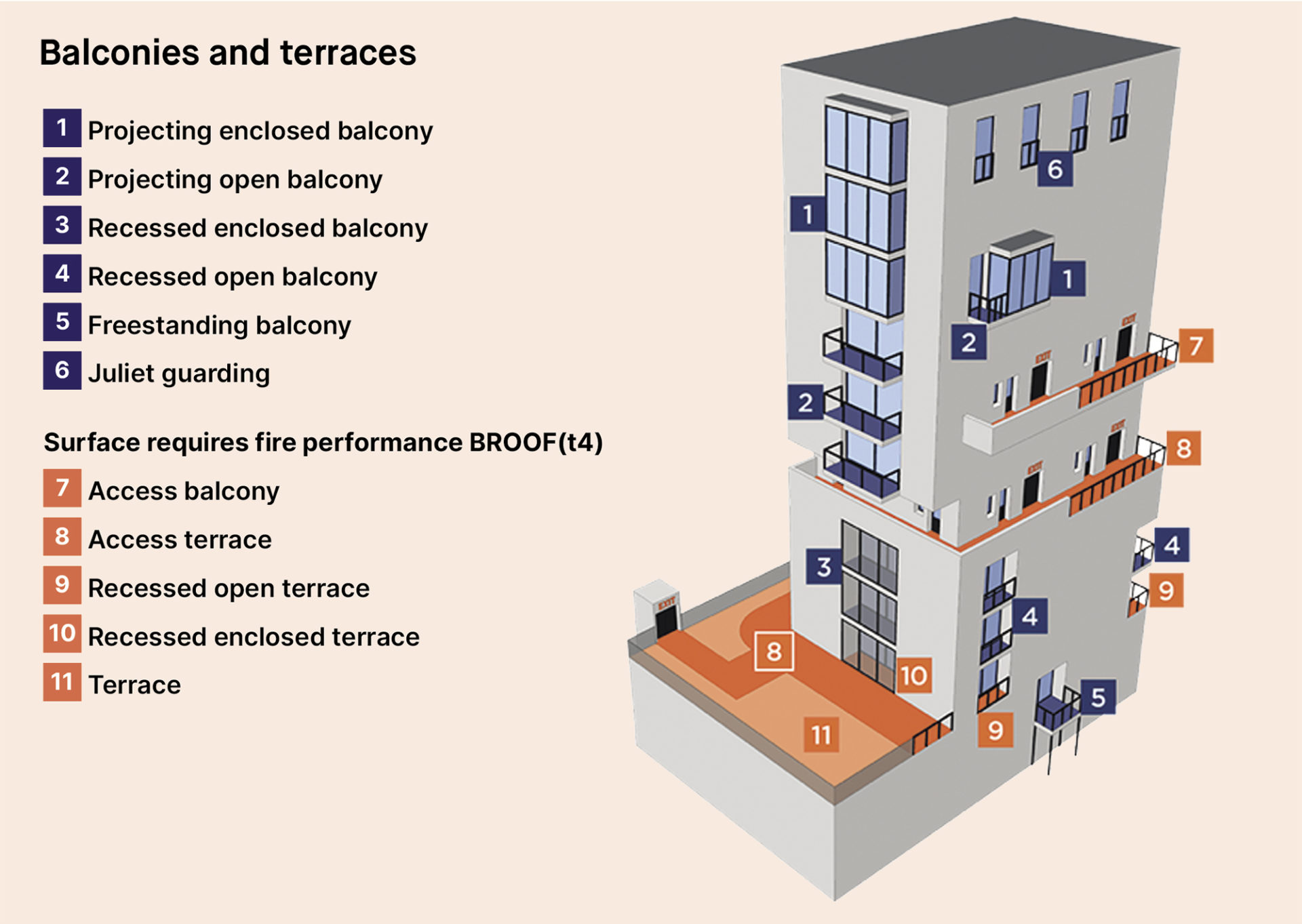
Attached balconies are differentiated from roof terraces in that they are not habited and conditioned spaces. They are usually bolted to or cantilevered from the external wall. Also included are most inset balconies. For the purposes of ADB, balconies are not deemed to be roofs unless designated to provide means of escape.
For areas that are correctly deemed to be balconies, that is, ‘specified attachments’ on ‘relevant buildings’, non-combustible material must be used. However, there is an exception made by Regulation 7(3) that excludes the waterproofing membrane from this requirement.
Termination of roofing materials
This exception has caused another serious area of confusion. Namely, how do you safely terminate a roof or balcony where it abuts a wall? Again, the LRWA, NFRC and SPRA guidance document has resolved this issue.
Insulation used as a thermal break on the face of a wall or abutment is exempt from the non-combustible ban provided it is no thicker than 60mm and does not go higher than 150mm above the finished roof level or walking surface. If, for any reason, the thermal break goes higher than this, or crosses an internal fire compartment line, non-combustible insulation must be used.
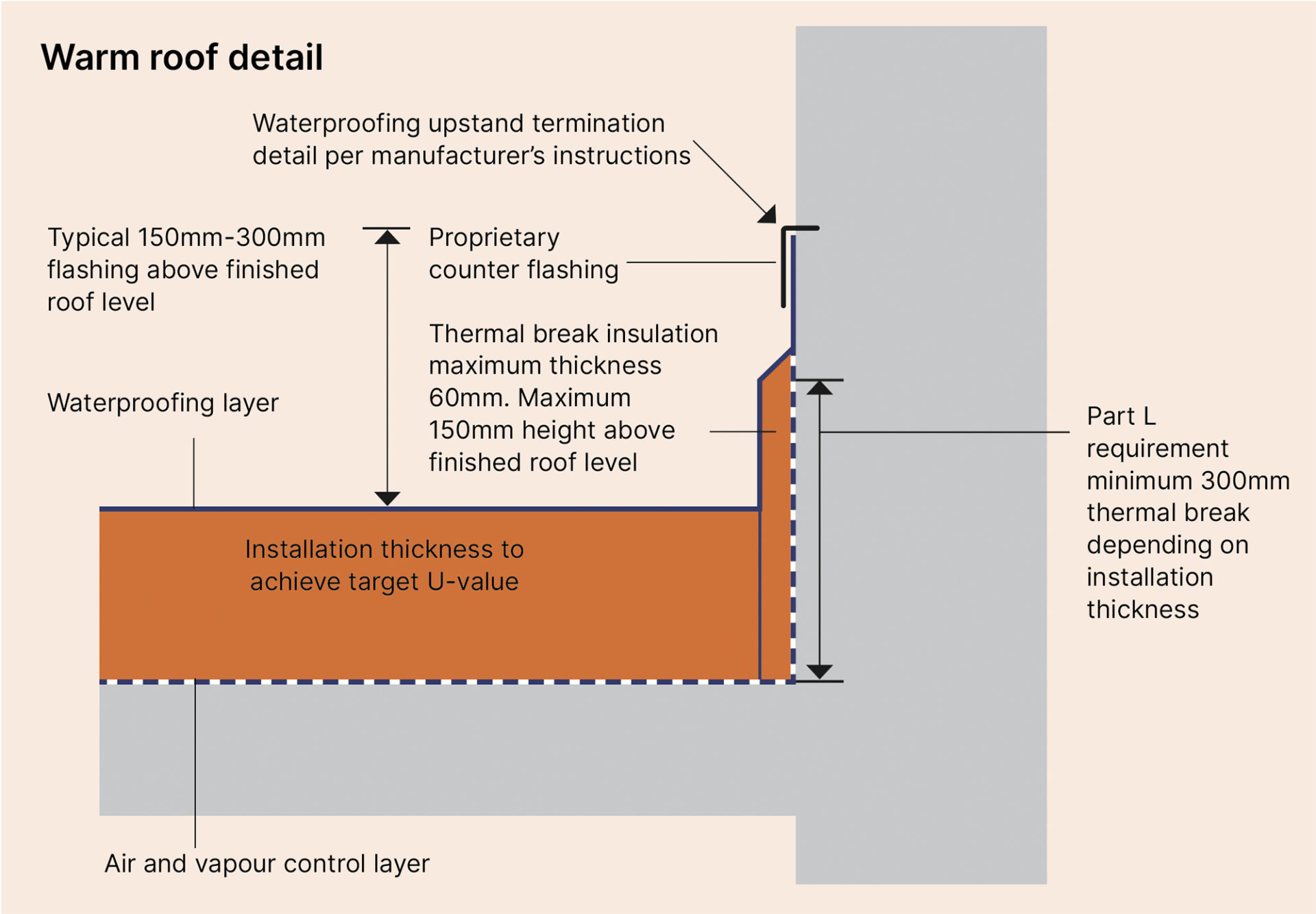
Requirement B3
Fire compartmentation is used internally to stop fire spread throughout a building. This basically entails separating the building into compartments using fire-resistant walls, floors and doors, so that the fire is contained within a single compartment in the event of a fire.
When a fire compartment wall forms a junction with the roof structure, the roof covering must be classified to BROOF(t4) and extend 1,500mm on either side of the wall. The roofing substrate or deck must be classed A2-s3 d2 or better.
In buildings under 15m high from ground level and purpose groups 1, 2, 3 or 5, other than 2(a), a substrate of B-s3 d2 or worse can be used. In all cases, fire-stopping is to be carried up to the underside of the roof covering.
Requirement B4
B4 sets out the requirements to prevent the external spread of fire for external walls and roofs. It states that:
- The external walls of the building shall adequately resist the spread of fire over the walls and from one building to another, having regard to the building’s height, use and position.
- The roof of the building shall adequately resist the spread of fire over the roof and from one building to another, regarding the use and position of the building.
The outermost material used for external walls must meet the combustibility requirements in Table 10.1 (see simplified version below). The distance to the boundary of the property, its height and use dictate materials that can be used.
For roofs, Requirement B4 sets out in Table 12.1 the required classification that the roof covering must achieve. The distance to the boundary of the property determines this. Only the highest classification BROOF(t4), can be used unrestricted on any building.
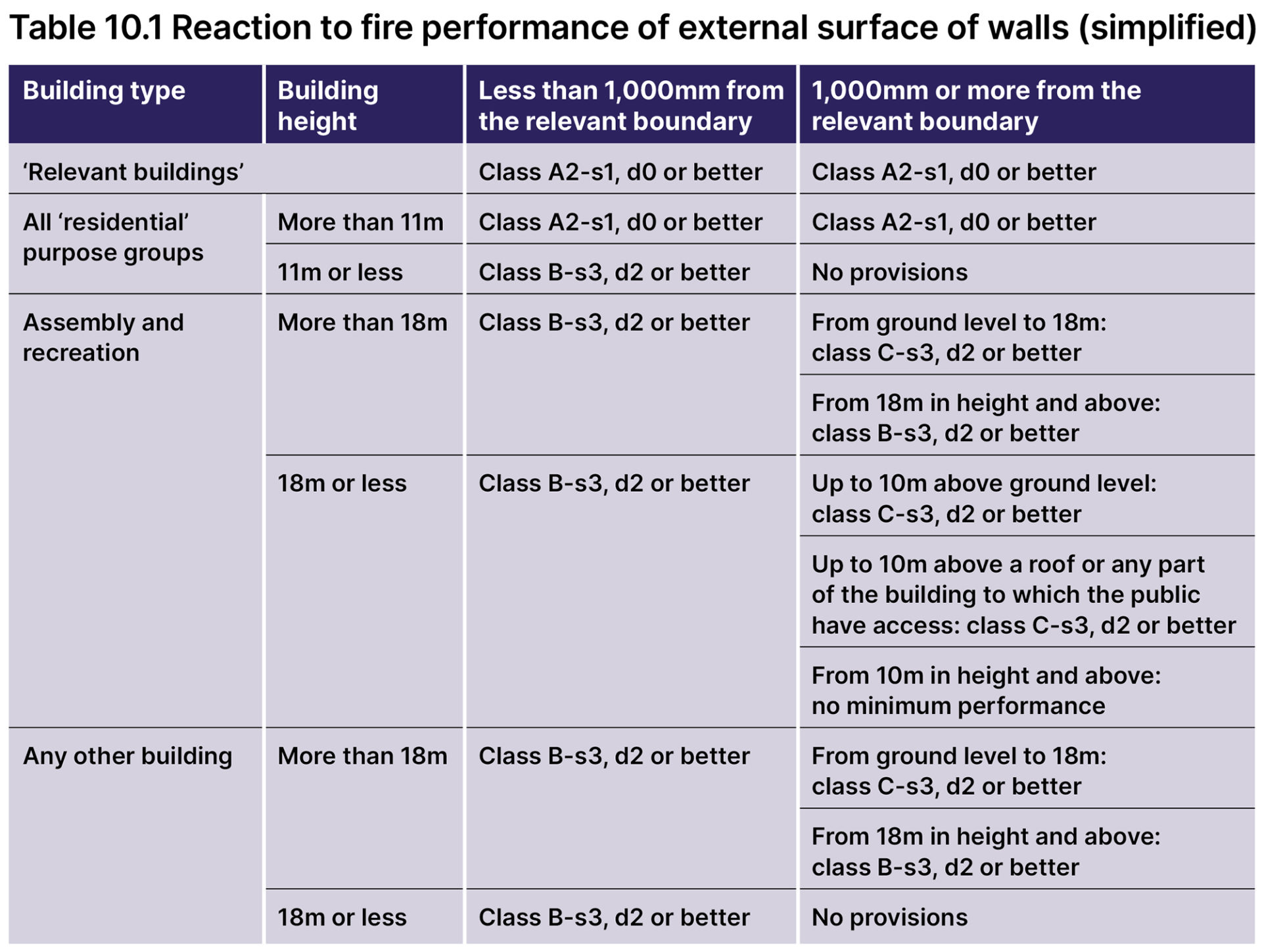
Fire testing classifications
CEN/TS 1187:2012 Test methods for external fire exposure to roofs dictates four test methods to determine a roof’s resistance to external fire exposure. Test methods 1-3 are widely used across Europe, with only the UK using method 4,
which incorporates two-stage testing and is more rigorous.
BS EN 13501-5
BS EN 13501-5: Fire classification of construction products and building elements. Classification using data from external fire exposure to roof tests sets out the required performance that the roofing system must attain to get its classification, with BROOF(t4) being the best and FROOF(t4) the worst performance, as shown in the table below.
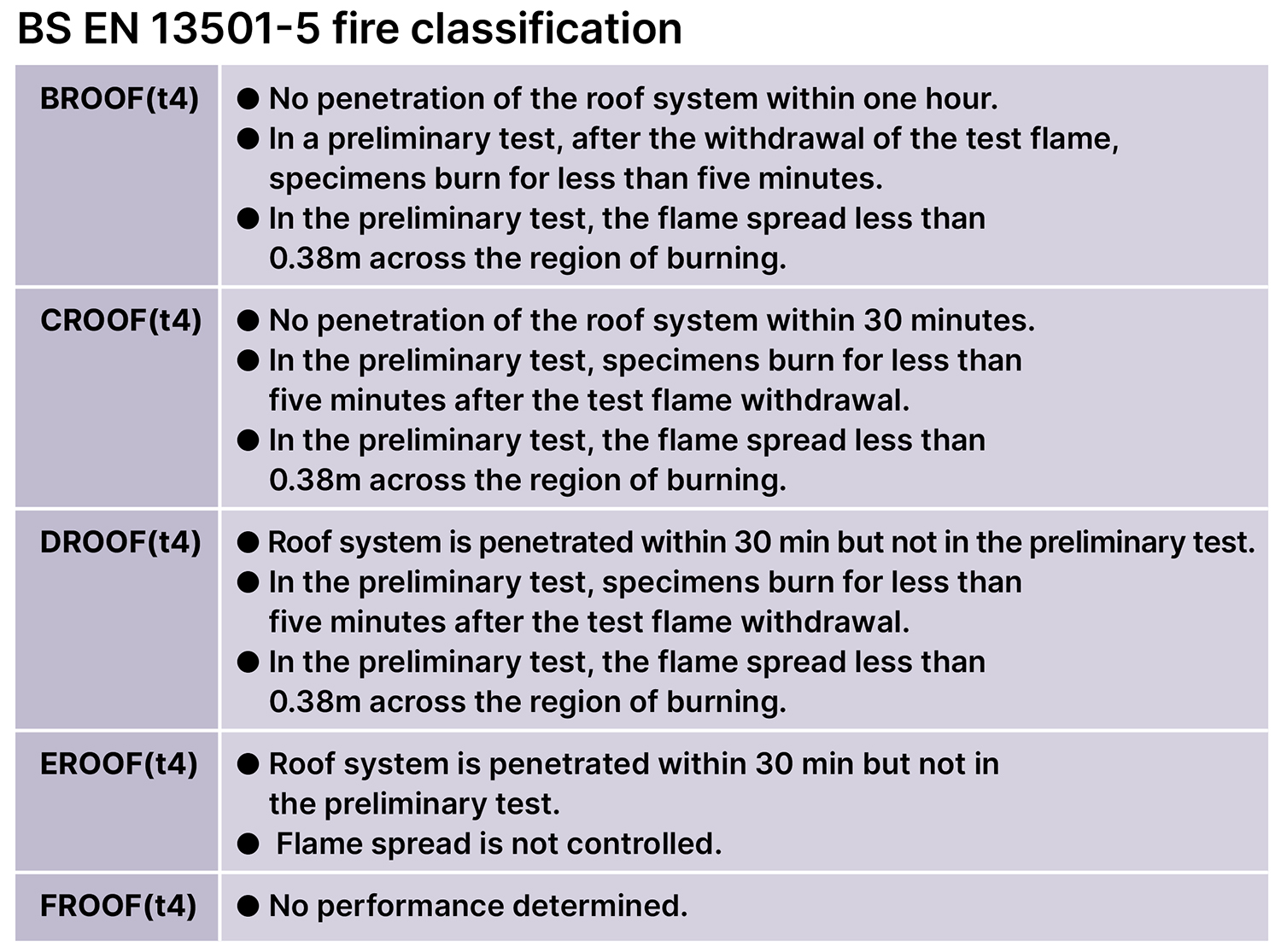
Fire Safety Order
The Regulatory Reform (Fire Safety) Order 2005 (also known as the Fire Safety Order) is a UK law that sets out the fire safety responsibilities of building owners and managers and the steps they must take to reduce the risk of fire and protect people in the event of a fire.
The Fire Safety Order applies to most non-domestic buildings in England and Wales, including:
- workplaces, such as offices, factories, and warehouses;
- public buildings, such as schools, hospitals, cinemas and museums;
- residential buildings, such as flats, hotels, hostels, boarding houses;
- assembly and leisure buildings, such as places of worship, community halls and sports stadiums;
- shops and retail premises; and
- mixed-use buildings.
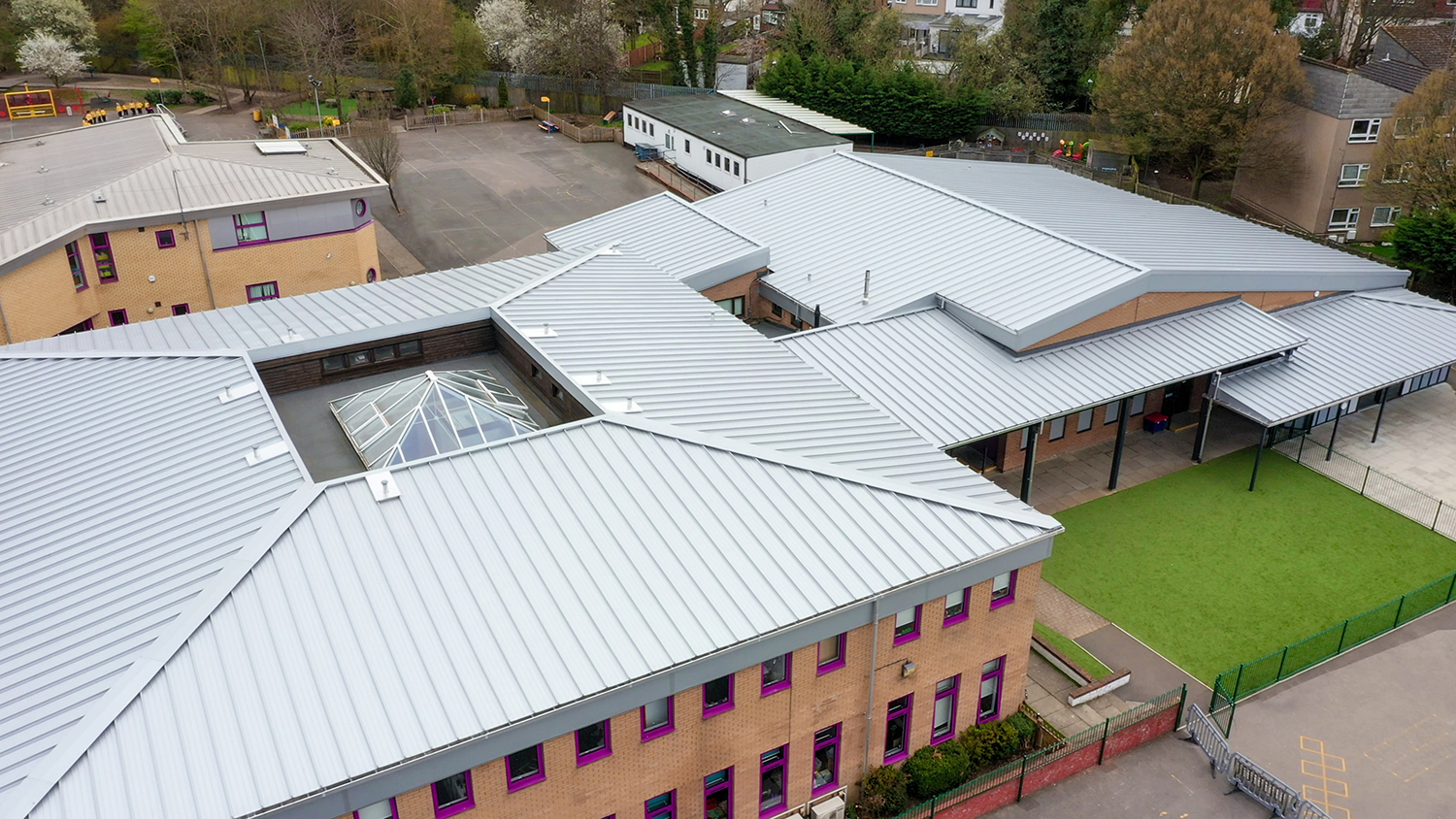
Single-family homes are not covered, although it does apply to multi-occupancy houses in multiple occupations (HMOs). The Fire Safety Order places responsibility for fire safety in buildings on the ‘responsible person’. Depending on the circumstances, this can be the building’s owner, manager or occupier.
The responsible person is responsible for:
- Ensuring that the premises reach the required standards.
- Providing employees or occupants with adequate fire safety training, which would include:
Induction training on fire awareness;
Periodic refresher or extra training where the level of fire risk increases as a result of changes in operations;
Training to support people in meeting their fire safety duties – for example, keeping ‘responsible people’ up to date; and
Training to build appropriate skills such as fire risk assessment, fire warden or using fire extinguishers.
- Conducting a regular fire risk assessment to:
Identify the fire hazards.
Identify people at risk.
Evaluate, remove or reduce the risks.
Record your findings, prepare an emergency plan and provide training.
Review and update the fire risk assessment regularly.
It’s important to note that these are general responsibilities, and the specific requirements can vary. More information is available from the government’s Fire Safety in the Workplace site.
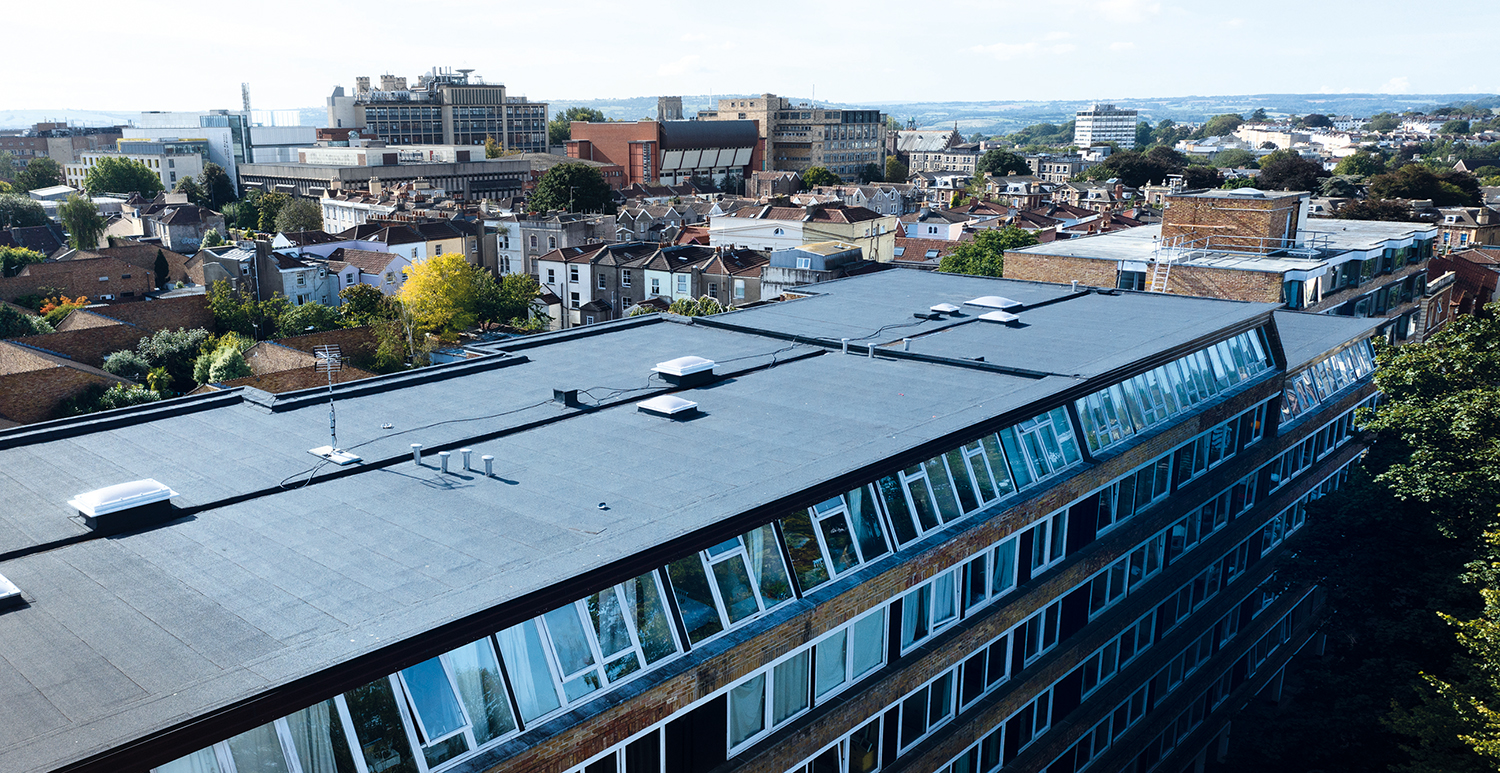
How can roofing be upgraded?
If, while conducting a fire risk assessment, you discover the roof is not up to standard, a number of potential solutions exist.
Cold-applied liquid roofing systems can be applied to most roofing surfaces without needing a full roof replacement. They can be installed quickly and will immediately reclass your roof to a BROOF(t4) standard.
If there are issues relating to the fire compartmentation where it joins the roof, internal works would need to occur.
This article has been produced by Construction Management in association with Garland UK




